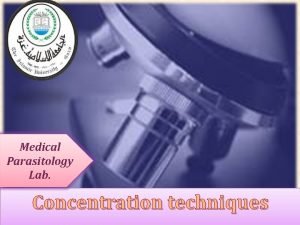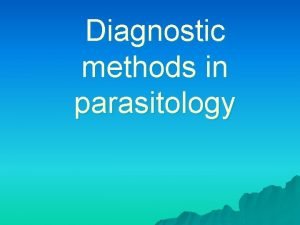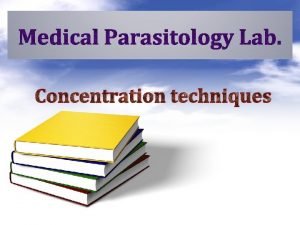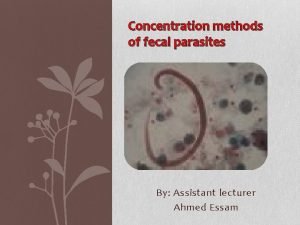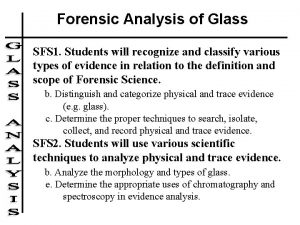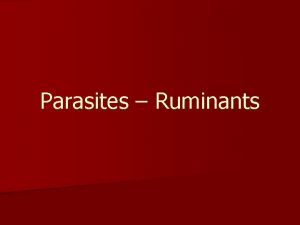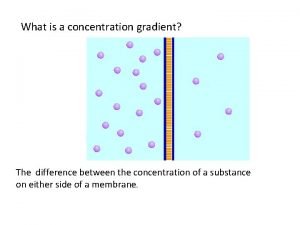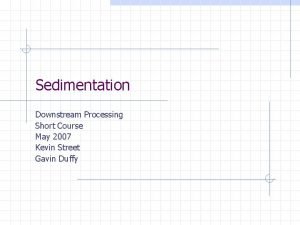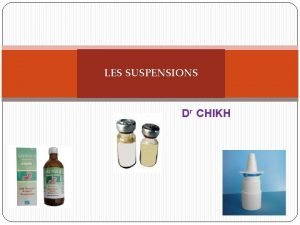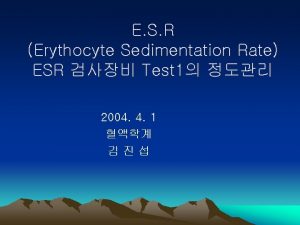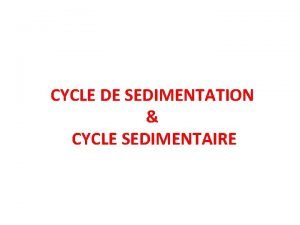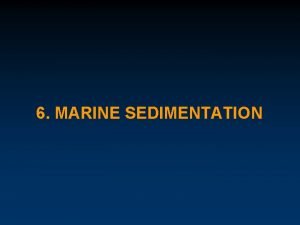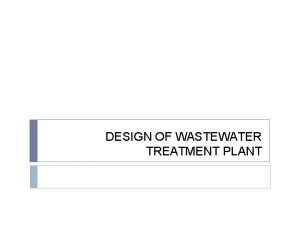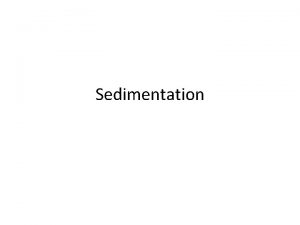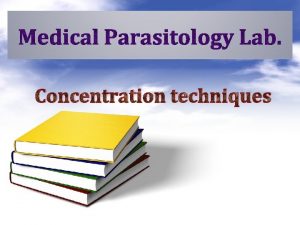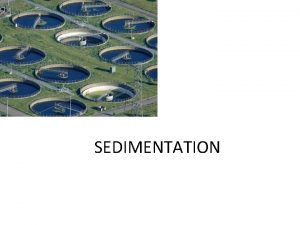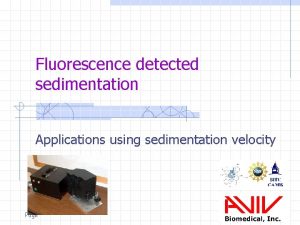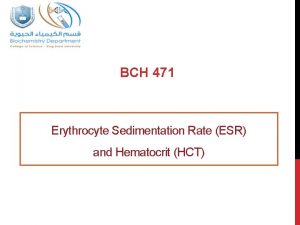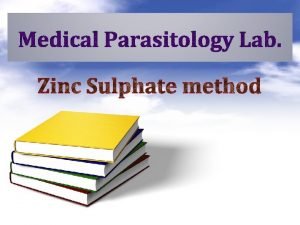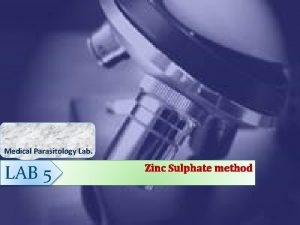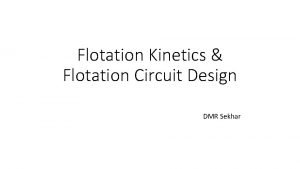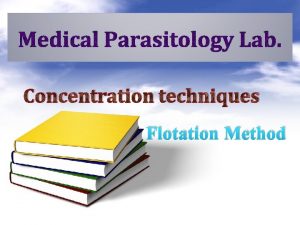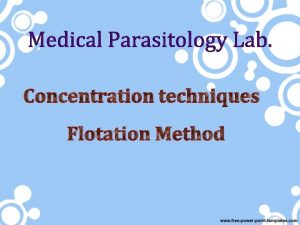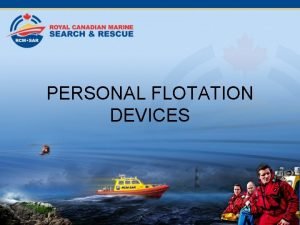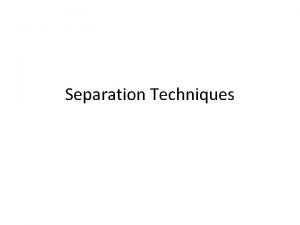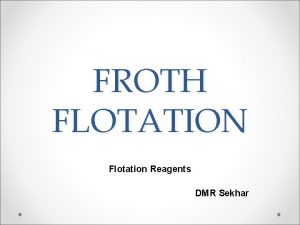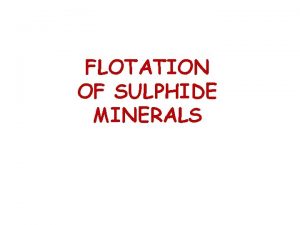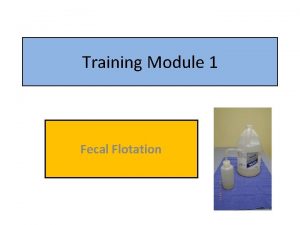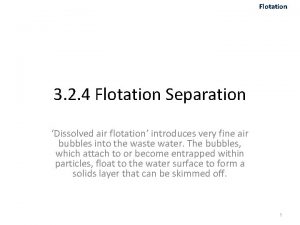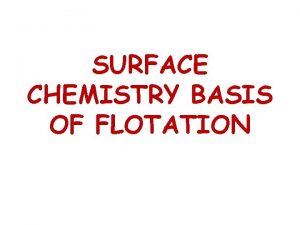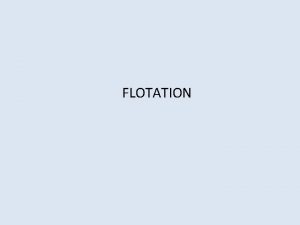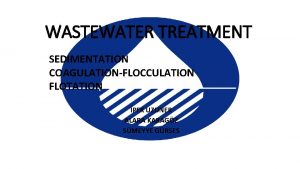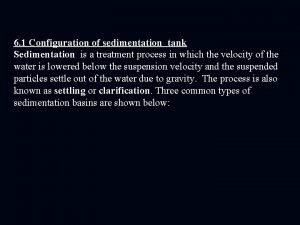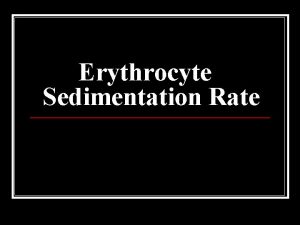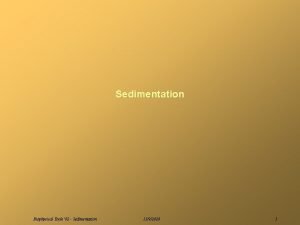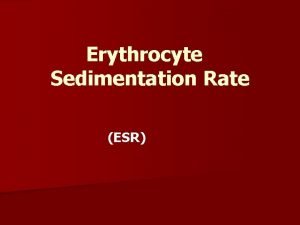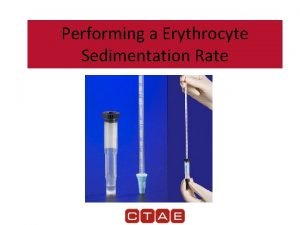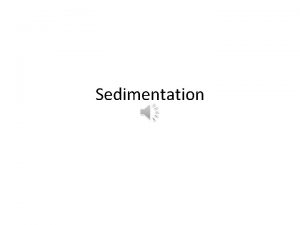Concentration techniques Flotation Method Concentration Methods 1 Sedimentation




























- Slides: 28

Concentration techniques Flotation Method

Concentration Methods 1. Sedimentation method § Modified Formal- Ether sedimentation technique § Acid- Ether sedimentation technique 2. Flotation method § Saturated Salt Solution technique § Sheather’s Sugar Centrifugal Flotation technique § Zinc Sulphate Centrifugal Flotation technique Raed Z. Ahmed, Medical Parasitology Lab. , 2012

Flotation technique § These method use the high specific gravity of a solution to float the lighter ova and cyst. They can be improved by centrifugation. • Advantage: • Easy to perform. • Disadvantage: • Delay in examination can result in distortion. • Larvae and some fluke eggs do not concentrate. • Frequent checking of specific gravity. Raed Z. Ahmed, Medical Parasitology Lab. , 2012

Flotation Methods SATURATED SALT SOLUTION Raed Z. Ahmed, Medical Parasitology Lab. , 2012

Materials and Method 1. Boil granular sodium chloride in excess in water to produce a saturated solution which when cooled has a specific gravity of 1. 18 - 1. 2. 2. Half fill a wide- mounted flat bottomed container with the saturated salt solution. 3. Emulsify 1 gm of feces in the solution and strain it to remove the debris from the surface. 4. Pour the filtrate into meniscus and fill it to the top with saturated salt solution. 5. Lay a glass slide or large coverslip over the top, avoiding any bubbles being trapped. 6. Leave for 20 min before quickly inverting the slide. 7. Scan for ova using the 10 x objectives. Raed Z. Ahmed, Medical Parasitology Lab. , 2012

Saturated Salt solution technique § Advantages: – It is cheap preparation using simple apparatus. – It concentrates nematode ova well. § Disadvantages: – It doesn’t concentrate cysts. Raed Z. Ahmed, Medical Parasitology Lab. , 2012

Flotation Methods SHEATHER’S SUGAR CENTRIFUGAL FLOTATION TECHNIQUE Raed Z. Ahmed, Medical Parasitology Lab. , 2012

Materials and Method § Sheather’s sugar solution: – Table sugar ------------------- 500 gm – Distilled water ----------------- 320 ml – Phenol crystal ( melt in hot water bath) ----- 6. 5 gm Raed Z. Ahmed, Medical Parasitology Lab. , 2012

Procedures 1. Soften 1 gm of feces with water to a soft. 2. Strain the aqueous suspension through a wire sieve. 3. Mix 1 part aqueous suspension with 2 part of Sheather's sugar solution. 4. Pour into a centrifuge tube, centrifugation 1500 rpm for 10 minutes. 5. Pour the supernatant into a meniscus and add a sufficient solution to bring the meniscus to the top. 6. Place a coverslip and wait for 10 minutes. 7. Examine under microscope. Raed Z. Ahmed, Medical Parasitology Lab. , 2012

Sheather’s Sugar solution technique § Advantages: – Reveals most nematode eggs and protozoan cyst. § Disadvantages: – Flukes eggs and tape worm eggs are not demonstrate well. – Also most nematode larvae are not demonstrate well. Raed Z. Ahmed, Medical Parasitology Lab. , 2012

Intestinal Protozoa Balantidium coli Raed Z. Ahmed, Medical Parasitology Lab. , 2012

Balantidium coli § Is a parasitic species of ciliate protozoa that cause balantidiasis or Balantidium dysentery. § Balantidium coli has two developmental stages, a trophozoite stage and a cyst stage. § The cyst is the infective stage measures about 50 to 70 µm in diameter, characterized by the presence of a large kidney -shaped macronucleus. § The trophozoite is oval with 2 nuclei and measures approximately 50 to 100 µm long and 40 to 70 µm wide. Raed Z. Ahmed, Medical Parasitology Lab. , 2012

B. coli Cyst Raed Z. Ahmed, Medical Parasitology Lab. , 2012

B. coli Trophozoite Raed Z. Ahmed, Medical Parasitology Lab. , 2012

Intestinal Protozoa Cryptosporidium parvum Raed Z. Ahmed, Medical Parasitology Lab. , 2012

Cryptosporidium parvum § Infect human and most mammals. § The infective stage is oocyst containing sporozoites measuring 5 u in diameter. § The diagnostics stage is sporocyst containing 4 sporozoites. § Diagnosis: – Detecting oocyst in stool. – Acid-fast stain. Raed Z. Ahmed, Medical Parasitology Lab. , 2012

Cryptosporidium parvum oocyst Raed Z. Ahmed, Medical Parasitology Lab. , 2012

Tissue Protozoa Toxoplasma gondii Raed Z. Ahmed, Medical Parasitology Lab. , 2012

Toxoplasma gondii • Habitat: reticulo-endothelial system, monocyte, and muscle fiber and cause toxoplasmosis. • Humans can acquire Toxoplasma gondii infection by ingestion cyst or sporylated oocyst – Cyst: precipitated in flesh of cow. – Sporulated oocyst: cat feces. o Intermediate host: Human. o Definitive host: Cat. • The tachyzoites are crescent-shaped and measure about 5 µm in length. • Diagnostic stages: – Diagnosis also can be done by detection antibody Ig. G, Ig. M, Ig. E and Ig. A. Raed Z. Ahmed, Medical Parasitology Lab. , 2012

Tachyzoites Raed Z. Ahmed, Medical Parasitology Lab. , 2012

Urogenital Protozoa Trichomonas vaginalis Raed Z. Ahmed, Medical Parasitology Lab. , 2012

Trichomonas vaginalis § Is the most common cause of vaginitis, inhabit the urogenital system § There is no cyst stage but only have trophozoite stage. § The trophozoite measures about 15 x 10 µm. The trophozoite has a single nucleus and four flagella and undulating membrane. § Diagnosis: – Male: finding trophozoite in urethral prostatic discharge – Female: finding trophozoite in vaginal discharge. Raed Z. Ahmed, Medical Parasitology Lab. , 2012

T. vaginalis Trophozoite Raed Z. Ahmed, Medical Parasitology Lab. , 2012

Intestinal Cestodes Hymenolepis nana Raed Z. Ahmed, Medical Parasitology Lab. , 2012

Hymenolepis nana § This is one of the most common cestodes of humans, especially children. And it’s the smallest tape worm in man, also called dwarf tape worm. § Eggs measures 30 -37 u, and have double membrane and contain six hooked oncosphere. § The scolex of H. nana has four suckers and a short rostellum with hooks. § Infective stage: Eggs. § Diagnosis: – Stool examination to detect the eggs. Raed Z. Ahmed, Medical Parasitology Lab. , 2012

H. nana egg Raed Z. Ahmed, Medical Parasitology Lab. , 2012

H. nana adult worm Raed Z. Ahmed, Medical Parasitology Lab. , 2012

H. nana scolex Raed Z. Ahmed, Medical Parasitology Lab. , 2012
 Floating and settling
Floating and settling Acid ether sedimentation technique
Acid ether sedimentation technique Sedimentation technique for stool concentration
Sedimentation technique for stool concentration Sedimentation technique for stool concentration
Sedimentation technique for stool concentration Ova cysts and parasites
Ova cysts and parasites Objective of size separation
Objective of size separation Pyrex glass forensics
Pyrex glass forensics Modified wisconsin sugar flotation method
Modified wisconsin sugar flotation method What is glass analysis in forensic science
What is glass analysis in forensic science Whats a concentration gradient
Whats a concentration gradient Movement of high concentration to low concentration
Movement of high concentration to low concentration Lovo tank
Lovo tank Sedimentation in downstream processing
Sedimentation in downstream processing Erythrocyte sedimentation rate principle
Erythrocyte sedimentation rate principle Loi de stokes vitesse de sédimentation
Loi de stokes vitesse de sédimentation Erythocyte sedimentation rate
Erythocyte sedimentation rate Schéma cycle sédimentaire
Schéma cycle sédimentaire Marine facies
Marine facies Clarifier tank design
Clarifier tank design An ideal horizontal flow settling basin
An ideal horizontal flow settling basin Giardia lamblia
Giardia lamblia Application of sedimentation in industries
Application of sedimentation in industries Sedimentation velocity
Sedimentation velocity Sed rate high
Sed rate high Advantages and disadvantages of flotation technique
Advantages and disadvantages of flotation technique Taenia solium
Taenia solium Boat flotation foam requirements
Boat flotation foam requirements Kinetics flotation reagents
Kinetics flotation reagents Wacc example
Wacc example

